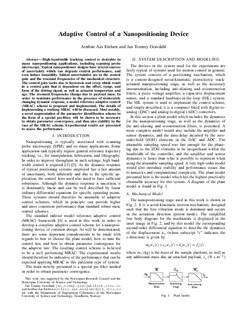| dc.contributor.author | Eielsen, Arnfinn Aas | |
| dc.contributor.author | Gravdahl, Jan Tommy | |
| dc.date.accessioned | 2017-06-08T06:52:12Z | |
| dc.date.available | 2017-06-08T06:52:12Z | |
| dc.date.created | 2013-01-15T15:20:27Z | |
| dc.date.issued | 2012 | |
| dc.identifier.citation | I E E E Conference on Decision and Control. Proceedings. 2012, 5065-5072. | nb_NO |
| dc.identifier.issn | 0743-1546 | |
| dc.identifier.uri | http://hdl.handle.net/11250/2445362 | |
| dc.description.abstract | High-bandwidth tracking control is desirable in many nanopositioning applications, including scanning probe microscopy. Typical nanopositioner designs have several sources of uncertainty which can degrade control performance, and even induce instability. Salient uncertainties are in the control gain and the resonant frequencies of the mechanical structure. The control gain varies due to hysteresis and creep which result in a control gain that is dependent on the offset, range, and form of the driving signal, as well as actuator temperature and age. The resonant frequencies change due to payload mass. In order to maintain performance in the presence of a moderately changing dynamic response, a model reference adaptive control (MRAC) scheme is proposed and implemented. The details of implementing a working MRAC will be discussed. Most notably, a novel augmentation of the parameter identification scheme in the form of a special pre-filter will be shown to be necessary to obtain parameter convergence, and thus also for stability and performance in the case of the MRAC scheme. Experimental results are presented to assess the performance. | nb_NO |
| dc.language.iso | eng | nb_NO |
| dc.publisher | IEEE | nb_NO |
| dc.title | Adaptive Control of a Nanopositioning Device | nb_NO |
| dc.type | Journal article | nb_NO |
| dc.type | Peer reviewed | nb_NO |
| dc.description.version | acceptedVersion | nb_NO |
| dc.source.pagenumber | 5065-5072 | nb_NO |
| dc.source.journal | IEEE Conference on Decision and Control. Proceedings | nb_NO |
| dc.identifier.doi | 10.1109/CDC.2012.6426799 | |
| dc.identifier.cristin | 989132 | |
| dc.relation.project | Norges forskningsråd: 192427 | nb_NO |
| dc.description.localcode | © 2012 IEEE. Personal use of this material is permitted. Permission from IEEE must be obtained for all other uses, in any current or future media, including reprinting/republishing this material for advertising or promotional purposes, creating new collective works, for resale or redistribution to servers or lists, or reuse of any copyrighted component of this work in other works. This is the authors' accepted and refereed manuscript to the article. | nb_NO |
| cristin.unitcode | 194,63,25,0 | |
| cristin.unitname | Institutt for teknisk kybernetikk | |
| cristin.ispublished | true | |
| cristin.fulltext | postprint | |
| cristin.qualitycode | 1 | |
